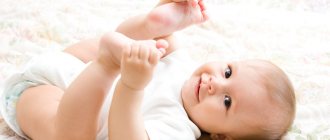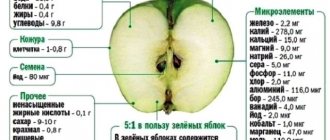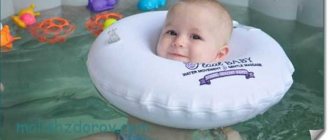When thinking about buying a baby carrier, considering existing offers, you need to understand from how many months you can carry a baby in a kangaroo. Even if the model says that it is allowed from birth, you need to understand how the baby will fit in the backpack and how the load will be distributed. When using carriers that are not appropriate for their age, there is a risk of harm to the baby’s health.
Kangaroo
Types of baby carriers
A baby carrier is chosen depending on the age of the baby. When a baby is born, his spine does not have the curves that adults have. They gradually form as the baby grows older.
Note! When the child begins to confidently hold his head, he puts a bend in the neck, and after he sits down, in the lower back. There is no need to rush things - this can lead to health problems in the future.
You can’t plant a baby before he grows up to it himself. When positioned vertically in a backpack, a large load is placed on the lower spine, tailbone and perineum. For a child who cannot sit independently, this is fraught with negative consequences. Therefore, the posture of babies in the first months of life should be as natural as possible. The baby either lies or cuddles up to the mother, and the soft tissue follows the natural curves and supports the baby.
Kangaroo, ergo-backpack or sling
Fabric slings, scarves or with rings can be used at any age; they are suitable for children from birth. There are several ways to place the baby in them: he can lie as if in a cradle, or face his mother, as if resting on her chest. The main thing is to support the baby's head. It's good when the sling has a hood.
An ergo-backpack can be purchased when the child can sit without support. In it, the load falls on the spine. In addition, the baby must gain a certain weight. If it is even lighter than 7 kilograms, it will not be able to fill the entire space of the backpack, which means it cannot be used. When the child is already sitting, you can carry it either behind your back or on your hip.
Child in an ergo-backpack
From 4 months, it is recommended to use an ergo-backpack, placing the baby facing the mother, while he should confidently hold his head. Kangaroos cannot be used for such babies:
- If it has a hard back, it is dangerous for a fragile spine. You need to wait until the baby sits down and an S-shaped curve appears.
- Narrower straps increase the load. Moreover, not only the baby feels it, but also the parents. If you consider that the baby in the kangaroo sinks greatly, hanging on the armpits, then it becomes even more difficult for mom or dad to move with him.
From how many months can you carry a baby in a kangaroo? My baby. Modern medical portal
Although the stroller is the leader in the list of the first transport for a child, for active parents it is an unnecessary ballast that prevents long walks or travel. Another thing is kangaroo backpacks. How interesting and fun it is for a child to walk with his mother, while feeling her warmth and protection. Everyone who has evaluated different types of baby carriers confirms that it is very convenient for both mother and baby. When to go to the store for a backpack and from how many months can we start carrying a baby in a baby carrier – we’ll find out in our article.
The undoubted advantages of backpacks
Kangaroos appeared on the domestic children's goods market relatively recently. For no more than 10 years they have been available for sale in all their variations. Remember how strange the scene of a mother leisurely strolling with a contented toddler sitting on her chest was back then. We shrugged our shoulders in bewilderment: “Why are they smiling?” And only after the passage of time, having given birth to our children, having personally experienced all the advantages of kangaroo backpacks, we know the answer: it was convenient and easy for them to walk, enjoying the sun, nature and communication with each other.
It is in a backpack that the baby feels safe, because mother’s hands and heart are so close. This means that viewing the world around us is much more interesting and calmer. For the mother, in turn, it is easy and convenient to walk with the child without pushing a bulky stroller in front of her. Your hands are free, the baby is fine - why not take a longer walk?
So at what month can you start wearing a baby in a baby carrier?
Manufacturers of kangaroos and pediatricians are unanimous on this issue: from the age of 4 months you can begin to briefly place the baby in a backpack. Some models (with a folding backrest in a vertical position) imply the use of a backpack from birth.
You need to start accustoming yourself to a kangaroo gradually: 15 minutes. per day - enough time for the baby to get acquainted with the new transport. After just a couple of weeks, the child can sit in it throughout the entire walk.
Of course, in order to prevent stagnation of blood circulation in the pelvic organs, it is better to periodically remove the baby and the kangaroo for 5-10 minutes. But these breaks are needed only during long trips and are useful not only for the baby, but also for the mother.
Now we know at what month you can start carrying your baby in a kangaroo backpack, which means you can safely prepare for active travel with the whole family.
Share with your friends!
https://www.happy-giraffe.ru/community/7/forum/post/95760/
In certain situations, using a stroller as a means of transport for moving a child creates some inconvenience or becomes completely impossible. For example, you are traveling and need to use the airport (train station) or need to travel on public transport, and your hands must be free. In these and many other cases, you can use kangaroo backpacks, you just need to know from how many months you can carry a child in them, so as not to harm his health.
Ease of use
This type of baby carriers appeared in the range of children's products relatively recently, no more than ten years ago. This improvised backpack is a great alternative to carrying a toddler in your arms. He can be seated either from his mother’s back or in front (facing her or away from her). It guarantees the convenience of traveling next to mom (or dad) for children under one year old. The baby likes to feel the close presence of a loved one, he is comfortable and the world around him can be clearly seen.
At what age can you start using it?
From birth to three months, carrying a baby in a kangaroo is only permissible in a horizontal position. Special models are produced for this purpose.
When the child holds his head well (starting from 3 months), you can carry him in an upright position and, accordingly, in a kangaroo backpack too. Some models are available for use from 6 months of age. When choosing a certain type, pay attention to the recommendations; the child’s weight is indicated there, since it can be different at the same age.
Acquaintance with new transport should begin gradually, approximately 15 minutes a day, increasing the duration every day. And in a couple of weeks, a full (1.5 hour) walk with a kangaroo is possible.
Safety
The backpack must have a hard back, preferably three positions including a lying position. Since the baby does not yet know how to sit, it is better to sit him facing you so that he reclines a little, creating a counterbalance to mom or dad, and reducing the load on his fragile spine.
It is not recommended to use kangaroo care for those children who have low muscle tone, and for mothers (or fathers) who have osteochondrosis, due to the creation of additional stress on the spine.
Recommendations when choosing a kangaroo backpack
- For a kangaroo, it is necessary to have wide and soft straps that create ease of use.
- It is better to choose a model with reliable fastenings - latches or carabiners and the presence of backup belts.
- It should be easy to put on and take off, and have a waist belt that ensures the safety of mom (dad's) spine.
- The kangaroo should be adjustable to the baby's height and have a high headrest that supports the head and neck if the baby falls asleep.
- The best models for use are those in which the toddler’s legs are spread wide apart, distributing the load on the hip joints. Avoid those options in which the baby seems to be hanging, where the pressure is on the perineal area.
- Additional comfort is provided by the soft fabric of the inner layer of the kangaroo and the attached bib.
According to parents' reviews, kangaroo backpacks from the following companies are easy to use: Baby Style Bimbo, Maclaren, Koala from Brevi, Original from BabyBjorn, Mothercare, Kanga from Globex, World of Childhood.
Whatever model you choose, the main thing is that the child and you feel comfortable.
Share with your friends:
https://www.fun4child.ru/8351-so-skolki-mesyacev-mozhno-nosit-rebenka-v-kenguru.html
From what months can you carry a baby in a kangaroo?
The little baby is growing by leaps and bounds and an integral part of his schedule, of course, is walks with his parents. Modern young mothers quite often do important things and it is more convenient for them to be more mobile by hiking with their child. And here the question arises about a “vehicle” for a child, convenient and, most importantly, safe. There is a solution, because especially for babies, the developers of various children's accessories have invented a backpack - a carrier, and for mothers this is a valuable find. But before buying and using this backpack, you need to figure out: from how many months can you carry a baby in it and how safe it is.
What types of baby carriers are there and what is a kangaroo carrier?
A baby carrier called a kangaroo was invented for busy moms who can't sit still. Its meaning is that the baby should be in the parent’s field of vision every second and at the same time his hands should be free.
At the moment, mothers and fathers have two different options for a backpack to choose from - carrying a small child:
- Transformable kangaroo - makes it possible to transport the baby in both a lying and sitting position. A distinctive advantage of this backpack is that the design is designed for the smallest children, that is, for newborns and, accordingly, it is possible to continuously be in close contact with your child.
- Kangaroo is a carrier for a sitting position - accordingly, the baby can only sit in it while sitting. When purchasing, in the instructions you can see clear recommendations regarding the age of the child - after four months, but in fact it is intended for babies who can already be planted.
In general, a kangaroo bag looks like a regular backpack with shoulder straps, only worn not on the back, but on the stomach.
Instructions for use of "kangaroo"
In a lying position, a parent can carry their baby from 3-4 months, in a standing position - from six months (provided that the baby sits on his own), and in a standing position and facing the outside world, it can be carried after a year.
The design in question has a minus: the entire mass of the child will load the shoulders of the one who carries it and, of course, not every mother will be able to carry 8 or even more kilograms for a long time. Such a daily long-term load can cause harm to the parent’s spine.
Contraindications for using a kangaroo carrier
Carrying a “kangaroo” has contraindications for babies:
- For diseases associated with the musculoskeletal system.
- With mental disorders.
- If there are limb fractures.
- Excess weight or, conversely, too little.
How long can you carry your baby?
Children's experts recommend not to exceed wearing time for more than 2 hours. That is, after this time it is necessary to take a long break of 5 hours and, if possible, even more, since constantly being in a carrier, which limits the baby’s movement, has a completely unfavorable effect on his physical development. To begin with, you can carry the child for 10 minutes so that he gets used to carrying and daily increase the time little by little up to two hours, but no more.
What are the requirements for the design and how to choose it correctly?
The main rules and requirements to ensure the safety of the baby:
- Durable fastenings, high-quality straps that secure the position of the child when carrying. The raw materials (material) from which all carrying elements are made must be of high quality, soft, not cause irritation, and not cause allergies. All components of the structure (zipper, buttons, rivets) must be made of hypoallergenic material, sharp corners are excluded to avoid injury to the baby or parent using the carrier.
- The rigid structure itself is usually made of fabric or even with two layers of synthetic padding. The fabric covering the structure should stretch well under load depending on the weight of the baby.
- The device should have the necessary holding elements and, ideally, several positions for carrying.
- The device must have the appropriate certification documents and a document confirming the product quality guarantee.
Kangaroo carriers of excellent quality are usually packaged individually when sold, and a document indicating the manufacturer and place where the product was produced is included in the package. For prefabricated structures, an assembly diagram and a list of elements included with the kit are attached.
Where to buy a kangaroo carrier and how much does it cost?
Of course, first of all, this product can be purchased in children's stores, or for those who are not in a hurry, there is a huge selection of online stores where you can choose from a variety of offers, read about each model, choose the desired color and, of course, an affordable price. The price range is quite large: from a thousand to 20 thousand. It all depends on the manufacturer, the material of the product, comfort, however, like any other thing.
If for some reason the kangaroo carrier does not suit the parents, but a means of transportation is still needed, you can consider a sling carrier as an option. This is a fairly simple design made of material that takes the shape of the baby and allows you to carry the baby while lying down (that is, it can be used from a month on). Disadvantage for parents: long preparation for use.
Carrying with your own hands
A huge selection of products for carrying is undoubtedly pleasing, but what to do if there are not enough funds for it. There is a solution - make the carrier yourself. What is needed for this:
- two meters of the densest material;
- meter of elastic;
- meter of cardboard;
- padding polyester and foam rubber.
We make a kangaroo carrier with our own hands:
- we cut out two straps - the upper length is 1.2, the lower length is 1 meter, the seating area is 50*30 cm from two elements;
- we fold them inside out and put padding polyester between them, sew along the seams, leaving one side unsewn;
- In the place where the back will be we insert cardboard and put foam rubber of the same size on it;
- future straps must be stitched several times;
- we cover the seat with dense material and stitch it;
- we sew the straps, strengthen the seams by sewing pieces of material to the place where the straps are connected;
- sew fasteners to the straps.
So, young parents undoubtedly have a choice, and a very large one. The main thing is to decide correctly and remember that the safety and health of a small child is paramount.
Author: Nedodel Tatyana
https://krohapuz.ru/uhod-za-mladencem/s-kakogo-vozrasta-nosit-rebenka-v-kenguru.html
No comments yet!
moyrebenochek.ru
How to choose a carrier
Sweetish smell of rot in the mouth of a child under one year old
Manufacturers assure that you can use a kangaroo carrier immediately after the baby is born. It is enough to purchase special inserts and liners designed for babies. The decision should be made by parents, understanding how the backpack works.
When choosing a kenguryatnik, you need to pay attention to the following points:
- the presence of an orthopedic hard back, which prevents the baby’s back from getting tired;
- fastenings are reliable and in good working order;
- natural materials were used for production;
- easy to wash and clean;
- The straps are adjustable, allowing you to use the backpack as your child grows;
- there is a belt on the waist that makes it possible to reduce the load on the mother’s spine;
- There is a headrest that allows the baby to feel comfortable while sleeping.
Description and purpose
It’s not for nothing that a kangaroo is called a backpack - they are very similar in shape: soft but strong straps, a spacious pocket. This baby carrier can be worn both over the shoulders and in front, and additional fastenings are attached to it so that it can be fixed on the belt.
The backpack can be used for babies from the first days of life - the ergonomics of some models allows you to lay the baby, and from 7 months the baby can be placed in a special section. In a lying position, it is convenient to feed and carry a child while sleeping, while in a sitting position, it is convenient to travel and go shopping.
Pros and cons of using a kangaroo
How to reduce a baby's temperature - reasons and methods
The useful properties of carrying include the following:
- The opportunity to do household chores without leaving the baby unattended, because the woman’s hands remain free.
- There is no need to take a stroller with you, especially if there are many curbs and stairs without ramps along the way.
- Helps establish an emotional connection between mother and baby, because they are constantly nearby. A baby, especially in the first months of life, needs close contact with a loved one.
- The child is less upset and cries, because the mother does not let him out of her arms, always talks to him and kisses him. He feels her breathing, hears her heart beating, and instantly calms down.
Disadvantages of a kangaroo sling:
- After landing, the child does not cling to his mother, he hangs. The baby falls through his butt, as if he were in a hammock. This increases the load on the spine and hip joints.
- There is a risk of exacerbation of dysplasia or its development, because the baby is in limbo. It stays in the armpits and crotch area. As a result, the load is distributed unevenly, which can affect the joints and spine of the baby if they are not strengthened or develop incorrectly.
- Mom gets tired quickly, because the child is not pulled towards her, and she reflexively turns away. As a result, the back quickly begins to ache. Pain also appears in the shoulder girdle if the upper straps are very narrow or incorrectly placed.
- The child's legs dangle, positioned quite low. This is another inconvenience for an adult, because they constantly get in the way while walking.
The baby does not cling to the mother, and the legs are too low
Instructions for use of "kangaroo"
When putting on a backpack, you need to be sure that the child is safe, all straps are securely fastened, and the knots are tightly tied. First, the backpack is fixed on the adult, then the child is placed there. Until he gets comfortable, he needs to be supported. Before the first use, it is better for the mother to put it on without the baby’s participation, check how everything works, and get used to the mechanisms and fasteners.
From what age can it be used?
How to accustom your child to a sleep and feeding schedule
"Kangaroo" becomes harmless for the baby in the first months of life if it can be placed in it in a lying position. It turns out that the baby is simply resting in the cradle on a hard and flat surface. You cannot sit a newborn baby, even if you place him facing his mother. Moreover, you cannot take a position where the baby looks around and has its back to the parent - it is intended for children older than 6-7 months. In addition, it is believed that if you sit a child in this way, allowing him to observe what is happening around him, he will become too excited, and this will negatively affect the state of his nervous system.
Maximum possible time in a sling
Pediatricians do not recommend spending several hours in a row in a sling. The optimal time spent without a break is 40-50 minutes, maximum 1.5 hours. After this, you need to get the baby out, you can give him a light massage and stretch his legs.
Note! If you are planning a long trip, when the child will be in the sling for 4-5 hours, then periodically you need to take him out and just hold him in your arms or put him in the crib.
Kangaroo for the little ones
How many months can a girl be placed in a kangaroo depends on when she sat down. The same rule applies to boys. There is an opinion that babies should not sit down before six months - this can affect the structure of the organs of the reproductive system. However, this fact is not supported by medical evidence. If the body is ready and the girl tries to sit down on her own, there is no point in stopping her.
Note! A backpack for babies should have a hood. Its main purpose is not protection from wind and rain, but insurance against sudden movements. If the mother walks quickly or bends over, the baby’s head will rest against the side.
A newborn should not be suspended in a backpack, positioned vertically. He should lie down, it’s too early for such a baby to sit.
Baby carrier
Device safety
You need to use a kangaroo backpack based on the recommendations. Then its use will be safe for both mother and child. It is necessary to place the baby so that he cannot fall out or move, as a result of which the belts will begin to put pressure on his legs. To do this, you need to use all the fasteners and check that they are securely fastened.
Note! A baby can be carried in a kangaroo only when he can sit confidently on his own.
This applies to the vertical position. Otherwise, it will negatively affect the baby's health.
From what months can you carry a baby in a kangaroo?
The little baby is growing by leaps and bounds and an integral part of his schedule, of course, is walks with his parents. Modern young mothers quite often do important things and it is more convenient for them to be more mobile by hiking with their child. And here the question arises about a “vehicle” for a child, convenient and, most importantly, safe. There is a solution, because especially for babies, the developers of various children's accessories have invented a backpack - a carrier, and for mothers this is a valuable find. But before buying and using this backpack, you need to figure out: from how many months can you carry a baby in it and how safe it is.
What types of baby carriers are there and what is a kangaroo carrier?
A baby carrier called a kangaroo was invented for busy moms who can't sit still. Its meaning is that the baby should be in the parent’s field of vision every second and at the same time his hands should be free.
At the moment, mothers and fathers have two different options for a backpack to choose from - carrying a small child:
- Transformable kangaroo - makes it possible to transport the baby in both a lying and sitting position. A distinctive advantage of this backpack is that the design is designed for the smallest children, that is, for newborns and, accordingly, it is possible to continuously be in close contact with your child.
- Kangaroo is a carrier for a sitting position - accordingly, the baby can only sit in it while sitting. When purchasing, in the instructions you can see clear recommendations regarding the age of the child - after four months, but in fact it is intended for babies who can already be planted.
In general, a kangaroo bag looks like a regular backpack with shoulder straps, only worn not on the back, but on the stomach.
Instructions for use of "kangaroo"
- in the “kangaroo” carrier, it is possible to carry the baby in a horizontal position, as well as vertically, while the child can look at the parent, or can have his back to him;
- if the baby is not yet quite confident in holding his head, then choosing a baby carrier with only a vertical position is categorically not recommended, since when transporting the baby his head is not fixed and can be injured;
- The “kangaroo” carrier is a rigid design and cannot completely take the shape of the baby’s body. In this regard, a baby who is not yet sitting independently cannot be carried in a “standing” position, so as not to load his still very weak and fragile spine. Accordingly, a vertical carrier is suitable for babies from the age of six months, when the baby begins to sit confidently and hold his back;
- It is not recommended to carry a baby in a vertical carrier for a long time, as there is an undesirable load on both the genitals and the hip joint;
- Child psychology experts advise carrying the baby facing you for up to a year, because the child most likely will not really like to constantly look at unfamiliar things and places. That is, at this very tiny age, the baby, constantly seeing his parents, feels safety and calm.
In a lying position, a parent can carry their baby from 3-4 months, in a standing position - from six months (provided that the baby sits on his own), and in a standing position and facing the outside world, it can be carried after a year.
The design in question has a minus: the entire mass of the child will load the shoulders of the one who carries it and, of course, not every mother will be able to carry 8 or even more kilograms for a long time. Such a daily long-term load can cause harm to the parent’s spine.
Contraindications for using a kangaroo carrier
Carrying a “kangaroo” has contraindications for babies:
- For diseases associated with the musculoskeletal system.
- With mental disorders.
- If there are limb fractures.
- Excess weight or, conversely, too little.
How long can you carry your baby?
Children's experts recommend not to exceed wearing time for more than 2 hours. That is, after this time it is necessary to take a long break of 5 hours and, if possible, even more, since constantly being in a carrier, which limits the baby’s movement, has a completely unfavorable effect on his physical development. To begin with, you can carry the child for 10 minutes so that he gets used to carrying and daily increase the time little by little up to two hours, but no more.
How to hold a newborn in your arms correctly (in a column, in a cradle)
What are the requirements for the design and how to choose it correctly?
The main rules and requirements to ensure the safety of the baby:
- Durable fastenings, high-quality straps that secure the position of the child when carrying. The raw materials (material) from which all carrying elements are made must be of high quality, soft, not cause irritation, and not cause allergies. All components of the structure (zipper, buttons, rivets) must be made of hypoallergenic material, sharp corners are excluded to avoid injury to the baby or parent using the carrier.
- The rigid structure itself is usually made of fabric or even with two layers of synthetic padding. The fabric covering the structure should stretch well under load depending on the weight of the baby.
- The device should have the necessary holding elements and, ideally, several positions for carrying.
- The device must have the appropriate certification documents and a document confirming the product quality guarantee.
Kangaroo carriers of excellent quality are usually packaged individually when sold, and a document indicating the manufacturer and place where the product was produced is included in the package. For prefabricated structures, an assembly diagram and a list of elements included with the kit are attached.
Where to buy a kangaroo carrier and how much does it cost?
Of course, first of all, this product can be purchased in children's stores, or for those who are not in a hurry, there is a huge selection of online stores where you can choose from a variety of offers, read about each model, choose the desired color and, of course, an affordable price. The price range is quite large: from a thousand to 20 thousand. It all depends on the manufacturer, the material of the product, comfort, however, like any other thing.
If for some reason the kangaroo carrier does not suit the parents, but a means of transportation is still needed, you can consider a sling carrier as an option. This is a fairly simple design made of material that takes the shape of the baby and allows you to carry the baby while lying down (that is, it can be used from a month on). Disadvantage for parents: long preparation for use.
Carrying with your own hands
A huge selection of products for carrying is undoubtedly pleasing, but what to do if there are not enough funds for it. There is a solution - make the carrier yourself. What is needed for this:
- two meters of the densest material;
- meter of elastic;
- meter of cardboard;
- padding polyester and foam rubber.
We make a kangaroo carrier with our own hands:
- we cut out two straps - the upper length is 1.2, the lower length is 1 meter, the seating area is 50*30 cm from two elements;
- we fold them inside out and put padding polyester between them, sew along the seams, leaving one side unsewn;
- In the place where the back will be we insert cardboard and put foam rubber of the same size on it;
- future straps must be stitched several times;
- we cover the seat with dense material and stitch it;
- we sew the straps, strengthen the seams by sewing pieces of material to the place where the straps are connected;
- sew fasteners to the straps.
So, young parents undoubtedly have a choice, and a very large one. The main thing is to decide correctly and remember that the safety and health of a small child is paramount.
You may also like
krohapuzz.ru
Contraindications when using a carrier
Children's doctor Komarovsky believes that it is possible to use slings for carrying newborns, the main thing is to position the child correctly. So, if a mother has chosen a “kangaroo”, then she must understand that carrying a baby in such a backpack for the first months of life is dangerous, because she will have to be placed there, which the baby is not yet ready for. The newborn must cling to the mother's body, which a kangaroo cannot provide.
The use of a carrier is prohibited in the following cases:
- The baby is overweight according to current age standards. Also, you should not purchase such an accessory if the baby, on the contrary, suffers from a lack of kilograms.
- Diseases or pathologies associated with the condition of the musculoskeletal system. This can affect both the spine and joints.
- Deviations of a neurotic or mental nature. Usually, in this case, the baby is seen by a neurologist; the purchase of a sling or backpack should be discussed with him.
- A child is seen by an orthopedist for developmental abnormalities, for example, he has hip dysplasia. The purchase must be agreed upon with a specialist.
Child at the orthopedist
It is useful for young mothers to know from how many months a kangaroo can be used, and how safe it is for newborns. Manufacturers do not always voice all the nuances; women, due to inexperience, can harm the baby. The main thing is to remember that you cannot force a baby to sit down; you can carry him vertically in a kangaroo when his spine is stronger. At the same time, you need to take care of the convenience for the mother: choose a position where the load is evenly distributed, otherwise pain in the back and neck cannot be avoided.











